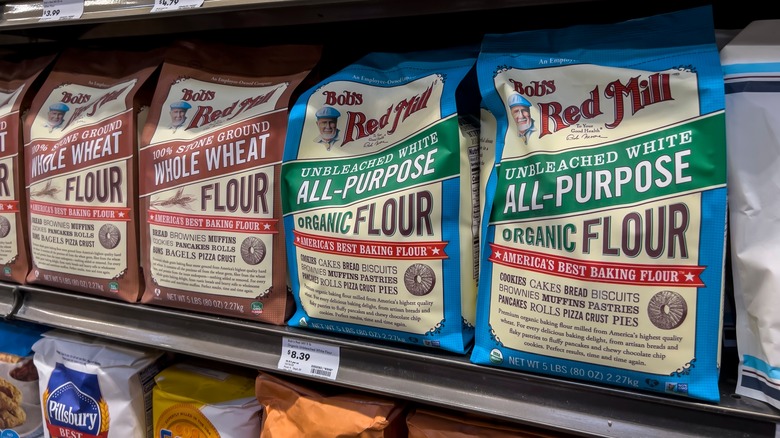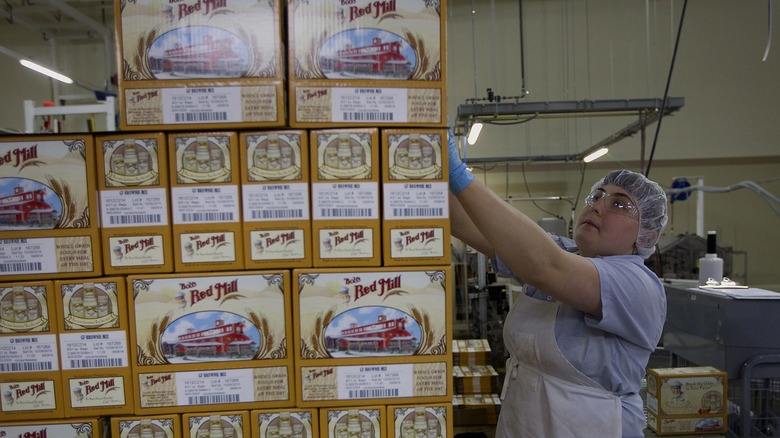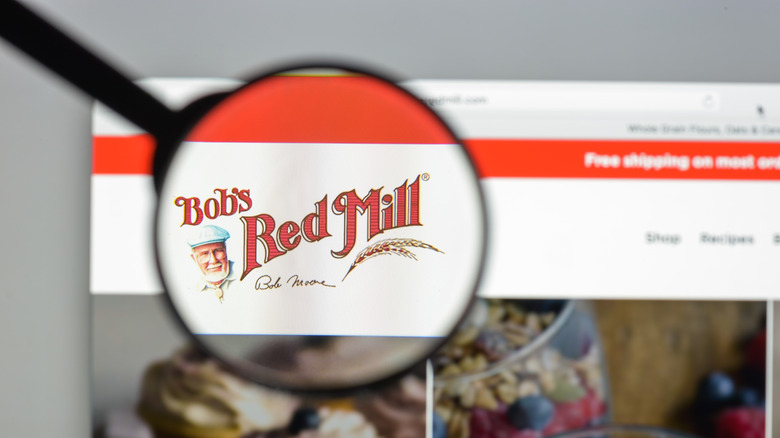How Bob's Red Mill Was Able To Reduce Its Food Waste By Over 70%
The type of garbage that takes up most of America's landfills isn't plastic — it's food waste. Per RTS, folks around the world toss out roughly 1.4 billion tons of food every year, and the U.S. alone contributes 80 billion pounds to that figure. That's more than the total combined food waste of Sweden, Germany, France, Italy, and the U.K., says Earth.org. Something has to give, right? Enter: Bob's Red Mill.
If you've ever bought millet, flax seed, buckwheat, or quinoa from a supermarket before, then there's probably a good chance you've come across the name Bob's Red Mill. While foodstuffs like these might already be culturally synonymous with an "earthy vibe," Bob's Red Mill has been working to prioritize the environment at the forefront of its operations. In 2021, 92% of the company's total food waste was sold to farms as animal feed, and the remaining 8% was donated to local charities, per a case study by Pacific Coast Food Waste Commitment (PCFWC). This year, the company reexamined its operational framework, from milling to packaging, to proactively curb food waste before it can even happen. It's a concept that Julia Person, Bob's Red Mill Sustainability Manager, calls "upstream prevention," via a press release from World Wildlife Fund. These proactive measures resulted in a decrease in food waste by over 70%. So, how did Bob's Red Mill make it happen?
Simple solutions provided by employees
To curb food waste, it's crucial to identify where the holes in your production line are. Bob's Red Mill understood this and consulted the folks who know the company's production process best: the employees. In collaboration with PCFWC and TripleWin Advisory, Bob's vetted all 176 of the ideas suggested by the employees of its facility in Milwaukie, Oregon, and plans to incorporate many of the suggestions into their production, per a press release from World Wildlife Fund.
According to the PCFWC case study, one of the most effective ideas was a fairly simple one: fix the Scale Buckets on Line 10. By regularly checking and tightening the bolts on the Scale Buckets, marginally less product could fall to the floor or overflow and spill out. This quick fix alone saved more than 70% of Bob's Red Mill's total food waste. Other manufacturers are likely experiencing problems like this, as well. In fact, the United Nations estimates that 14% of all harvested food is lost during production. Of the remaining 86% that makes it out, another 17% is wasted by retailers and consumers. This uncomplicated but transformative fix could lead the way for other production plants to analyze their floor operations.
The future of food waste
In addition to saving money on production costs, says Julia Person via the press release, reducing food waste means slowing climate change and making a dent in the global hunger crisis. According to the United Nations, food waste is responsible for a whopping 10% of total global greenhouse gas emissions. Looking forward, Bob's Red Mill has announced plans to keep the sustainability ball rolling. The company recently joined the Pacific Coast Food Waste Commitment to further cut food waste in half by 2030. Bob's Red Mill's Oregon facility already has an on-site 120 kW solar energy system and charging stations for electric cars.
When the company 86ed the paper lids from its Oatmeal Cups, it cut 170,000 pounds of waste per year. Small-but-mighty changes like these could turn the tides of the global food waste crisis in a major way — and it might be coming not a moment too soon. The USDA estimates that Americans waste a whopping 30%-40% of their total food supply. Already high food waste has been further exacerbated by the pandemic, says RTS, as quarantines and remote work and schooling caused takeout sales to soar. As consumers and manufacturers alike step into a post-pandemic world, combating climate change is our next task, and Bob's Red Mill is leading by example.


